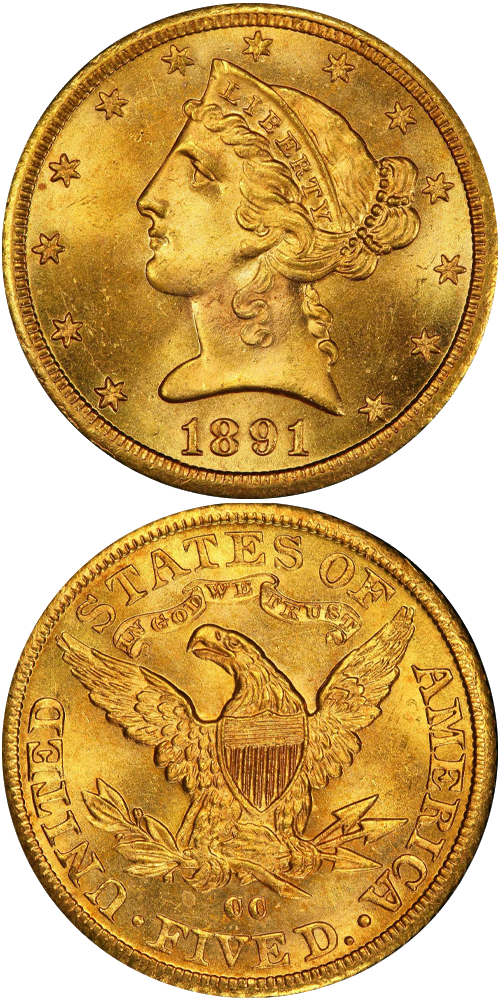1891-CC Liberty Head Half Eagle
Jeff Ambio: Two obverse dies and a single reverse were used in two marriages to strike all known 1891-CC half eagles. On Winter 1-A, the date is positioned low in the field and is much closer to the denticles than the base of the neck. A middle to late die state for the obverse, exhibiting several faint die cracks contiguous to several of the stars, particularly numbers 1 through 6 before Liberty's portrait.
Rusty Goe: Why did the Carson City Mint's coining department deliver more gold half eagles in 1891 than in any other year of that institution's existence? Mint Director Edward O. Leech, in his 1891 annual report, did not provide a definitive answer, but he explained why Congress had amended a coinage act from 1882 regarding the exchange of gold coins for gold bars, saying, "specially-powerful causes were operating" in the United States at the time. One of the effects of those "powerful causes" had left the Treasury Department "powerless to stop the movement of gold ... from this country." Over a period of six months, February-July, the United States exported over $70 million in gold to Europe; almost $66.5 million was in coin form. Financial disasters in recent years in European countries had precipitated their demand for gold.
Charles Foster had succeeded William Windom as Treasury Secretary after Windom's untimely death in early 1891, and two of his earliest actions further facilitated the huge exportations of gold coins. First, he declined to furnish U.S. made gold bars to European buyers who paid for them with their own countries' coins. Congress had even passed a law in March 1891 that gave the Treasury Secretary the discretion to impose a surcharge on the purchase of gold bars. So desperate were buyers in Europe, however, they paid the premiums. The Secretary raised the premiums higher until the purchase of U.S. gold coins was more enticing, which in turn caused the draining of the Treasury's reserve of gold coins to escalate.
Foster's second measure occurred when he agreed to redeem the Treasury Notes and greenbacks held by wealthy U.S. bankers in the East in gold. Some historians have said that these savvy financiers conspired with their counterparts in Europe to deplete the U.S. Treasury's gold reserves. During the summer of 1891, this might have correlated with Mint Director Leech's "powerful causes were operating" statement. Regardless, the records are clear: massive quantities of U.S. gold coins, many in small denominations, made their way onto large steamships and sailed across the Atlantic to Europe.
Orders coming in for silver dollars and the two small gold denominations kept the Carson City Mint operating at full capacity, at least through 1891. Superintendent Wright had no option at one point in July than to ask 16 of his employees to take a pay cut rather than be terminated, but still business chugged along.
The coining department turned out 122,000 half eagles in the first half of 1891, and between July and December it delivered another 86,000 to bring the annual output to 208,000. For the second year in a row the Carson Mint led the nation in half eagle production.
Thanks to large quantities being locked away in European vaults for decades, collectors today have a relatively large population of 1891-CC half eagles from which to choose, even a significant quantity of high-quality examples in grades MS-63 to MS-64.
Q. David Bowers: From the 1891-CC half eagle mintage, I estimate a survival quantity of close to 2,000 circulated coins, mostly EF and AU. Regarding Mint State coins my figure is somewhere close to 1,000, mostly MS-60 to MS-62 or even slightly higher. These are plentiful in the context of Carson City half eagles. Most are from overseas holdings brought back in the 1980s and, especially, the 1990s. However, even before that time there were many in numismatic circles in America, many via James F. Kelly of Dayton, Ohio, circa the 1950s and 1960s. Where he found them overseas is not known, but by the time I was associated with him in business his overseas agent Paul Wittlin was finding France to be a rich source.
The example to the left was sold by Stack's Bowers Galleries in the D. Brent Pogue Part VII Sale, where it realized $45,600.






